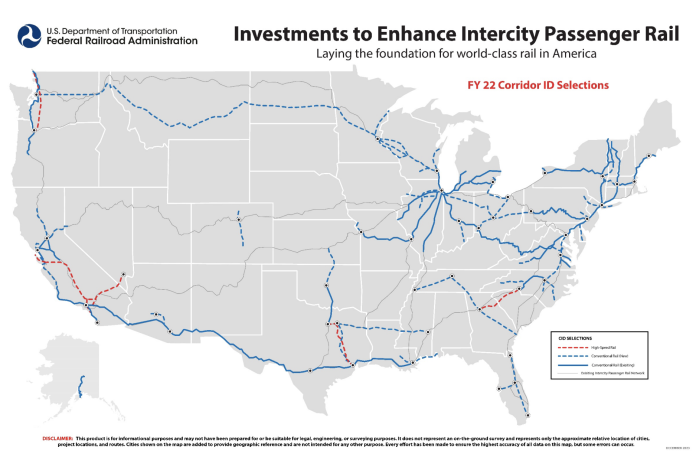
Washington State came up short in its bid for a larger $198 million grant to advance high-speed rail planning.
On Friday, the Federal Railroad Administration (FRA) unveiled its selection of rail projects that will be getting a windfall via President Biden’s 2021 Infrastructure Investment and Jobs Act. This “Corridor Identification and Development” (Corridor ID) program selected dozens of proposed corridors across the country, including three in the Pacific Northwest. Washington State Department of Transportation (WSDOT) proposals for Amtrak Cascades enhancements and the new Cascadia Ultra High-Speed Ground Transportation corridor both made the cut.
Leading local officials and corporate leaders have expressed interest in connecting Seattle, Portland, and Vancouver, British Columbia with high-speed rail and while the grant announced Friday is small, it could signal greater federal support down the road.
“WSDOT is very pleased to receive federal support for both important passenger rail programs,” Secretary Roger Millar said in a statement. “These two complementary systems would connect with one another to transport people in efficiently, reliably and in environmentally friendly ways. We’re planning improvements for current rail passengers, as well as envisioning an even more robust system in the future.”
Another proposal sponsored in Montana also made the cut and would restore Amtrak’s North Coast Hiawatha long-distance service. Potential routings could serve several cities in Washington and Oregon.
As result of the selections, the FRA will provide up to $1 million in grants to WSDOT to continue work on planning infrastructure improvements and expanded frequencies for Amtrak Cascades and planning the new Cascadia High-Speed Ground Transportation corridor.

WSDOT’s Cascades work is primarily focused on the Portland to Vancouver, British Columbia segment, but the department will also coordinate with the Oregon Department of Transportation (ODOT) to fold in its planning work for the Portland-Eugene segment. In October, WSDOT outlined some preliminary concepts for service growth over the next 20 years. On the high end, the concepts chart Cascades service levels reaching 16 daily roundtrips between Seattle and Portland plus six daily roundtrips between Seattle and Vancouver, British Columbia. ODOT has indicated that it could pursue up to six daily Cascades roundtrips between Portland and Eugene.
WSDOT is also working through its high-speed rail body of work, which could eventually bring bullet trains to Cascadia serving a half-dozen or so major cities between Vancouver, British Columbia and Portland with potential extension to Eugene. To date, the department has completed a feasibility study, business case analysis, and framework for high-speed rail authority. Work is now underway to develop scenario planning as well as a coordinating, governance structure given the binational, tri-state/provincial nature of the project.
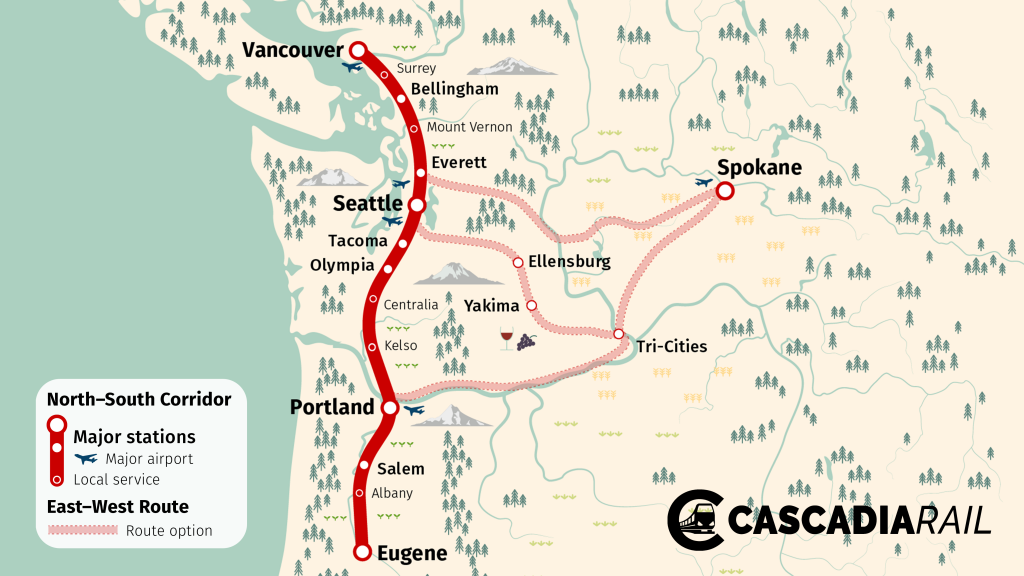
As part of Friday’s announcement, federal officials were particularly bullish on backing high-speed rail corridors like Cascadia’s.
“Corridor selections announced today create a strong pipeline of projects that will drive future passenger rail expansion in America,” FRA Administrator Amit Bose said in a statement. “The Federal Railroad Administration is particularly excited about the potential of the Cascadia High-Speed Rail Corridor selected through FRA’s Corridor Identification and Development Program. This program provides the necessary tools to advance the Cascadia Corridor, and FRA is eager to work with the Washington State Department of Transportation and other stakeholders to do just that.”
In addition to its Corridor ID effort, WSDOT filed an application for the FRA’s Federal-State Partnership for Intercity Passenger Rail grant to further support the Cascadia high-speed rail program. The department had hoped to win support for $198 million in deeper planning and early design work but wasn’t successful in this year’s federal funding cycle. It was up against some big competitors in California and Nevada. Proceeding through the Corridor ID process, however, would help the Cascadia high-speed rail project become more competitive in future funding cycles.
Big Sky Passenger Rail Authority in Montana will also receive up to $500,000 in grants to support its work on planning restoration of the North Coast Hiawatha long-distance service. The service would be routed from Chicago to Seattle or Portland via Spokane and Pasco. It would also travel through parts of Idaho, Montana, North Dakota, Minnesota, and Wisconsin. It essentially is an alternative routing of the Empire Builder and would restore an Amtrak route that had been discontinued in 1979.
Janet Matkin, WSDOT’s rail communications officer, said that the department isn’t a party to the Montana-sponsored proposal. The department is instead focused on its own state-sponsored intercity passenger rail programs. But if the Big Sky Passenger Rail Authority is successful in its effort, it seems some coordination could be useful to align overlapping Amtrak services across Washington and Oregon.
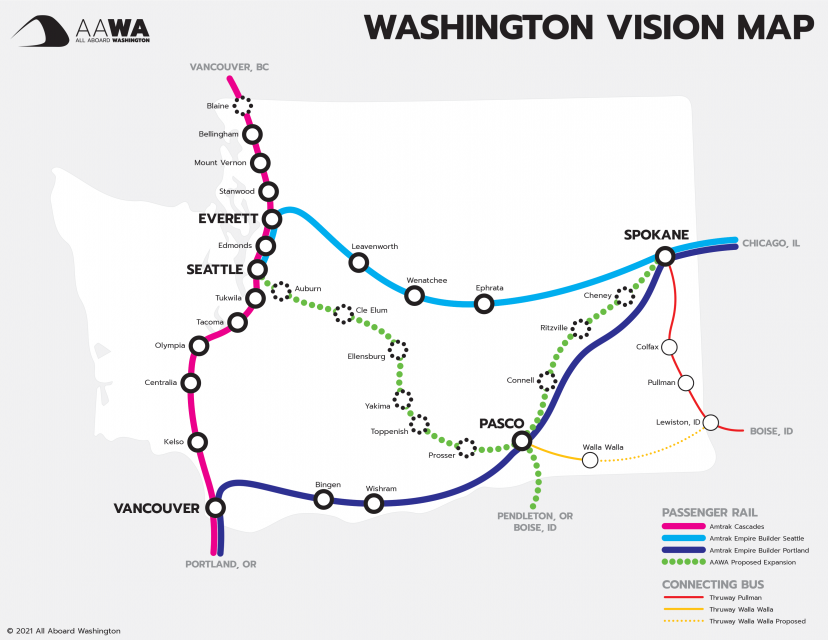
Matkin also said that WSDOT hasn’t filed any other Corridor ID applications at this time. There is, however, some rail advocacy support in the Pacific Northwest for restoration of the former Amtrak Pioneer long-distance service between Seattle/Portland and Boise as well as a new east-west intercity passenger rail corridor between Seattle and Spokane via Yakima and Pasco. WSDOT did publish a preliminary study of the latter in 2020.
All three Pacific Northwest projects selected to enter the Corridor ID program will start with Step 1. As part of this, project sponsors are expected “to develop a scope, schedule, and cost estimate for preparing, completing, or documenting its service development plan,” according to the FRA. If successful, the projects can advance through the next stages of Corridor ID’s three-step process.
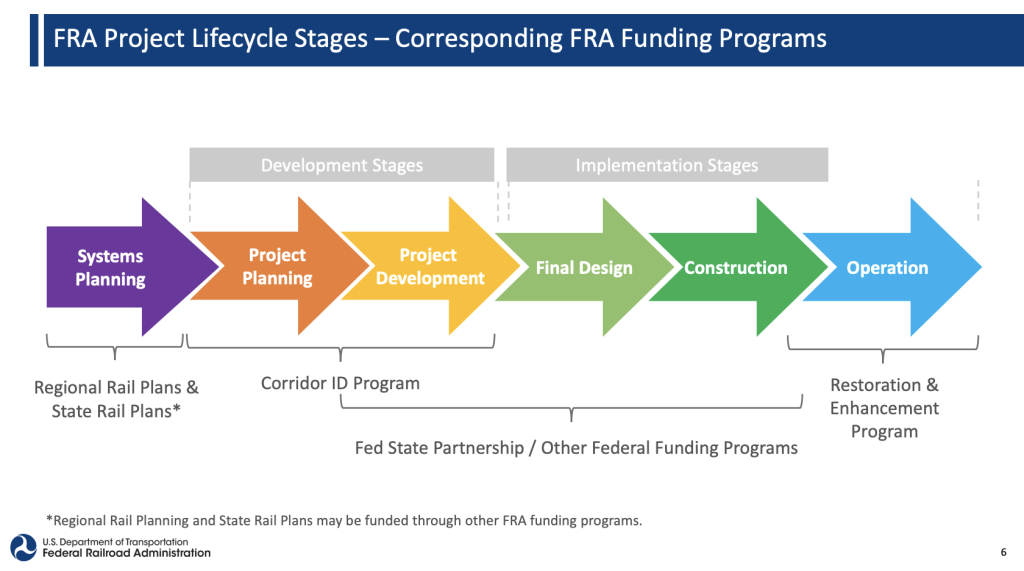
In Step 2, projects would be required to formally develop a Service Development Plan (SDP) in collaboration with the FRA. That step would come with additional federal funding, which is dependent upon completion of the scoping work of Step 1. Project sponsors would also have to put up 10% in matching funds to qualify for grant funding. Then in Step 3, a project sponsor would advance to project development by carrying out environmental review and conducting preliminary engineering, with the understanding that the project is likely to be implemented. The SDP would help determine the level of grant funding that the project is eligible for in Step 3, but project sponsors would also have to provide 20% in matching funds.
Each step may take around a year, but could take more or less time, depending upon project complexity and sponsor readiness. The FRA has outlined a broad rubric of how much effort that sponsors will need to put into projects. Existing corridors like Cascades that are seeking improvements will require less work than entirely new lines Cascadia high-speed rail or the North Coast Hiawatha. But WSDOT has already done substantial work for both of their projects, so they may be in a higher status of readiness than similar projects across the country.
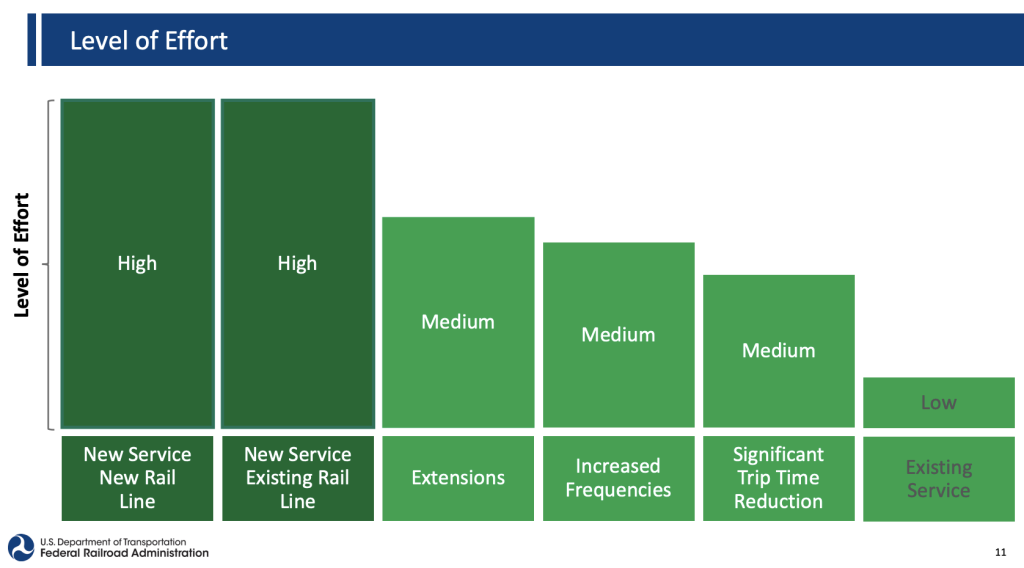
Projects that complete the three-step process would be in line for federal funding to implement them.
As to the future of the Corridor ID program, the FRA plans to make it a permanent framework with routine opportunities to propose new corridors and enter into the program. So while this is the first selection of corridors into it, additional cycles for funding and participation in the process will be available. The goal of it is ultimately to help states and other project sponsors go through a vetting and readiness process for projects that could be realized, expanding intercity passenger rail.
With dozens of projects entering the Corridor ID program this year, the FRA could have quite the pipeline of projects ready for deeper federal investments in just a few years, some of which could be headed right for the Pacific Northwest.
Stephen is a professional urban planner in Puget Sound with a passion for sustainable, livable, and diverse cities. He is especially interested in how policies, regulations, and programs can promote positive outcomes for communities. With stints in great cities like Bellingham and Cork, Stephen currently lives in Seattle. He primarily covers land use and transportation issues and has been with The Urbanist since 2014.


